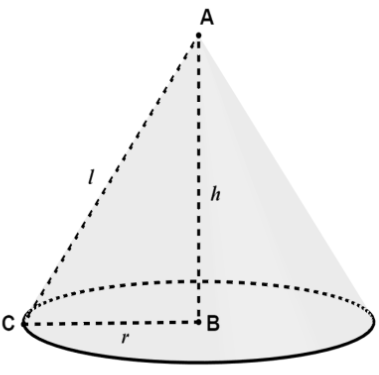Question
Question: Show that the semi-vertical angle of the cone of the maximum volume and given slant height is \({{\c...
Show that the semi-vertical angle of the cone of the maximum volume and given slant height is cos−131.
Solution
We will use the formula for the volume of the cone, which is given by V=31πr2h. We have a given slant height. So we will use the trigonometric relations to rewrite the radius and height in the formula of the volume in terms of slant height and the semi-vertical angle of the cone. We will find the maximum volume of the cone by differentiating it and equating it to zero. Using this information, we will be able to calculate the semi-vertical angle of this cone.
Complete step-by-step solution
The volume of the cone is given by V=31πr2h where h is the height of the cone and r is the radius of the base. Now, let us look at a diagram of the cone.

We have a triangle formed by the radius, height, and slant height of the cone. The radius and height are perpendicular to each other. In the right-angled triangle ΔABC, let the semi-vertical angle ∠BAC be denoted by θ. In ΔABC, using the trigonometric relations, we can write
sinθ=lr and cosθ=lh. Therefore, we have r=lsinθ and h=lcosθ. Substituting these values of radius and height in the formula for the volume of the cone, we get
V=31π(lsinθ)2(lcosθ)=31πl3sin2θcosθ
Now, we want to maximize the volume of the cone. The volume is maximum when dθdV=0. Differentiating the volume of the cone with respect to the semi-vertical angle, we get the following expression,
dθdV=dθd(31πl3sin2θcosθ)=31πl3dθd(sin2θcosθ)
We know that dxd(f(x)⋅g(x))=f(x)dxd(g(x))+g(x)dxd(f(x)). Applying this rule to the above expression, we get
dθdV=31πl3dθd(sin2θcosθ)=31πl3[sin2θdθd(cosθ)+cosθdθd(sin2θ)]
We know that dθd(cosθ)=−sinθ and dθd(sin2θ)=2sinθcosθ. Substituting these values in the above equation, we get
dθdV=31πl3[sin2θ(−sinθ)+cosθ(2sinθcosθ)]=31πl3[−sin3θ+2sinθcos2θ]=31πl3sinθ[−sin2θ+2cos2θ]
We also know that sin2θ+cos2θ=1. So, we will substitute −sin2θ=cos2θ−1 in the above equation, we get
dθdV=31πl3sinθ[cos2θ−1+2cos2θ]=31πl3sinθ[3cos2θ−1]
Now, we will equate the above equation to zero.
31πl3sinθ[3cos2θ−1]=0
So, this implies that either sinθ=0 or 3cos2θ−1=0.
We know that if sinθ=0, then θ=0∘. We will have to discard this possibility because the semi-vertical angle of a cone cannot be θ=0∘. So, the only possibility is 3cos2θ−1=0.
This implies that cos2θ=31. So, we have cosθ=31. Therefore, we have the semi-vertical angle as θ=cos−131. Hence, proved.
Note: It is important to understand that we get the critical points of a function f(x) by equating the derivative to zero, dxdf(x)=0. The critical point tells us that the function can have either a maximum value or a minimum value at that point. To check whether the critical point is a maximum or a minimum, we compute the second derivative of that function. If the second derivative is positive, then the critical point is a local minimum and if it is negative, then the critical point is a local maximum. This is called the second derivative test.
